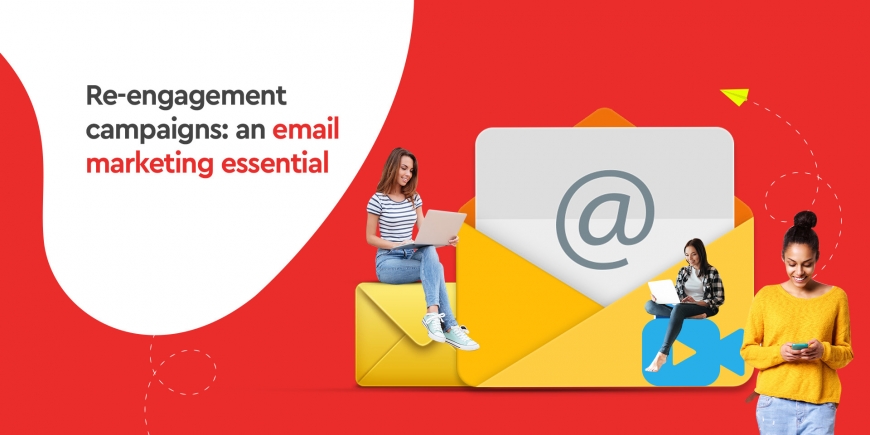Re-engagement campaigns: an email marketing essential
When someone is as priceless as a cherished customer, it hurts to see them lose interest in you.
If you’re experiencing this, it’s time to launch a re-engagement email campaign.
Re-engagement emails can be extremely beneficial to your company. They give you the opportunity to re-engage dissatisfied customers or, in some cases, to let them go for better.
And all of your searching has led you here. Because you’ll find everything you need to know about running a successful re-engagement email campaign here, from reasons to types to hacks and everything in between.
But, before we get into that, let’s define what a re-engagement email is.
What Are Re-Engagement Emails?
A re-engagement email, also known as a win-back email, is sent to subscribers who haven’t opened your emails in a while. The goal of sending a re-engagement email is to entice inactive subscribers to reconnect with you.
What is the Importance of Re-Engagement Emails?
One of the most important reasons for sending re-engagement emails is that interacting with an old customer is easier than acquiring new ones.
Additionally, they raise the email campaign engagement rate, which increases revenue for your company.
Moreover, there’s a good chance that your sender’s reputation will suffer if you send emails to recipients who don’t interact with them. This is avoided by sending re-engagement emails.
Not only that, but the cost of designing and sending emails is quite high. Furthermore, re-engagement emails allow you to distinguish between recipients who want to hear from you and those who do not, making it easier to send emails only to active email recipients.
An underappreciated benefit is that your old customers connect with you differently; it will be difficult to re-establish that rapport with new customers.
Wondering how one re-engagement email can have such a wide range of positive effects? We were as well. And we’re confident that you’re now even more eager to launch a re-engagement email campaign.
Let’s now explore the 5 types of re-engagement emails you can send to your clients.

5 Re-Engagement Email Formats That Will Win You Back Your Customers
Sending your cherished subscribers the next type of email will allow you to experiment with your re-engagement emails.
1. One that reaffirms your worth to customers
Always keep in mind that there was something unique about you that inspired your subscribers to join your email list in the first place – something that can improve their lives.
Through your email of re-engagement, remind them of this value. Because it’s likely that despite their busy schedules, your customers are still interested in what you have to offer.
Therefore, in this situation, a reminder email can be very helpful. However, if things have soured and they feel that your service or product is no longer valuable to them, this email reminder may be interpreted as a sign that they are no longer interested in you.
If so, you should stop sending them emails because doing so might damage your sender’s reputation.
2. One that solicits customer feedback
Communication is essential for healthy relationships.
No, that isn’t just common sense, but it also works wonders for customer relationships.
You can send re-engagement emails to your customers asking for feedback. You’ll be able to figure out what went wrong between you two this way.
Such emails can include questionnaires or rating scales. This encourages your email recipients to provide you with honest feedback and interact with your emails.
3. One that entices customers with new products or features
If your company has launched a new product or service, it’s time to promote it in your re-engagement email.
It’s a smart way to entice your subscribers to interact with you again. Because your subscribers are likely to have lost interest in your previous products or services, the new ones may entice them to engage with you again.
4. One that offers incentives to customers
Offering an incentive is one of the most effective ways to re-engage customers.
You can provide them with a discount or something for free. Customers love promotional emails, so it’s unlikely that they’ll decline an email like this.
However, make sure your email design and copy clearly communicate your message and are appealing enough to entice your subscribers to take advantage of this offer.
5. One that triggers a customer’s emotions
Human emotions have an impact on marketing. You’ll be able to run almost all of your email campaigns successfully if you understand how to target these emotions.
In that vein, another effective campaign idea for a re-engagement email is to appeal to your subscribers’ emotions.
You can tell them that you miss them or that you believe your subscribers have abandoned you and that you would like to hear from them again.
Aside from that, you can win them over again with a hilarious email copy.
Re-Engagement Emails as a Solution to Apple’s New Privacy Policy
With a 60.7% market share, Apple is the most popular email client.
However, with Apple’s recent privacy changes, email marketers are finding it difficult to track down inactive email subscribers. Because Apple Mail has made it impossible to determine whether or not your email was opened.
As a result, open rates should no longer be used to calculate your email subscribers’ engagement rate.
Not only that, but Apple has enabled its users to hide their email addresses, making it extremely difficult for us email marketers to track down those who haven’t responded to our emails.
The good news is that sending a re-engagement email to your email recipients will allow you to determine whether or not the subscriber has engaged with you.
Doesn’t that make re-engagement emails appear to be a panacea?
Having said that, we believe you are now prepared to learn the five essential steps to creating a re-engagement email.
Let’s get right to it.
How Do You Write Superb Re-Engagement Emails?
To create high-performing re-engagement emails, follow these 5 simple steps:
Step 1: Decide a time period as a disengagement period
To avoid any misunderstanding, the first step in launching a re-engagement email campaign is to determine the time period to be considered as the “period of inactivity or disengagement.”
It can be 2-3 weeks, one month, or six months – the choice is entirely yours. Simply choose a time frame and clearly communicate it to all of your campaign team members.
Also, make sure that all of your subscribers have the same period of inactivity.
Step 2: Determine the reasons for their disengagement.
The next step is to determine what is causing your customer’s lack of communication and interest. As previously stated, there could be several reasons for this.
You can directly ask them using questionnaires or review forms.
Step 3: Identify inactive subscribers.
Once you’ve determined why your subscribers aren’t engaging with your emails, segment them accordingly.
For example, all email subscribers who are uninterested in your email because they are uninterested in the product can be placed in one category, while subscribers who have not engaged with you because you send emails too frequently are placed in the other.
You will be able to create personalized emails for each of your subscribers as a result of this. Just so you know, 55% of email marketers prioritize email personalization, and you should too.
Step 4: Construct eye-catching emails.
Now is the time to put your creativity on display.
Create an aesthetically pleasing re-engagement email that will not only stand out in your recipient’s inbox but will also motivate them to respond.
Step 5: Send emails and evaluate the results
It’s time to automate and send these re-engagement emails after you’ve segmented your email list and created your emails.
Remember to send each subscriber the emails he or she is entitled to. After that, evaluate the effectiveness of your email campaign. Determine the flaw in your strategy if it isn’t performing well. Celebrate if it performed well.
To be honest, we’re pretty sure the latter will occur because you now know almost everything about running a successful re-engagement email campaign.
But, before you get too excited, we recommend that you incorporate the best practices listed below into your re-engagement email campaign.
Making High-Converting Re-Engagement Emails: Best Practices
We know you want to give this campaign your all and leave no stone unturned.
In fact, we want you to do it as well. As a result, we’ve compiled a list of best practices for you to incorporate into your re-engagement email campaign, which will improve the performance of your emails by encouraging readers to respond.
Use eye-catching subject lines to catch their attention.
If you haven’t paid close attention to your email’s subject line, you should because 47% of people open emails based on the subject line.
Make them as catchy as possible in order to capture the attention of your subscribers. And personalize it to entice them to act in your favor.
Send a sequence of emails
Yes, there is such a thing.
Send multiple re-engagement emails. This will give your message more weight. Not to mention that it increases your chances of converting your subscribers.
Allow your subscribers to specify their email preferences.
Your subscribers may have stopped engaging with your emails because you were sending them too frequently or because the content was uninteresting to them.
You can avoid this by asking your subscribers what they want.
For example, if a customer wishes to receive emails from you only once a month, he or she can make that request, and you can accommodate them accordingly.
This practice was implemented by Animoto in their re-engagement email, and it is without a doubt admirable.
Give them the option of opting out.
We cannot emphasize how critical this is.
Make it easier for recipients of your emails to unsubscribe. We say it with a heavy heart, but an unsubscribed subscriber is preferable to an inactive one because the latter jeopardizes your sender’s reputation.
Remember to include clear unsubscribe options in your email design and copy.
Final Thoughts:
And that’s all there is to it. That’s basically everything you need to know before launching a successful and high-converting re-engagement email campaign.
We are completely committed to your success.
And, yes, if you want to re-engage your disengaged contacts, our team of experts can create great re-engagement email campaign strategies to better suit your brand or business and improve your customer experience in a matter of months.
Start implementing your re-engagement strategy right away!
665 total views
There are no comments



